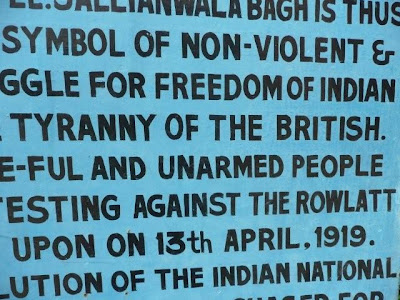
Battling my way out of the train station, we are inundated with touts. I want to walk to the bus station – only a couple of km according to LP, but no one knows where it is, not even the police! Ignoring everyone, I follow my instincts, and eventually we get there. Again scores of touts, but we reach the inside and check the buses to Srinagar.
No direct buses, we need to go to Jammu, which I had been expecting. Buses run every 20 minutes, which is great, but they stop at 5:30pm, not great. If a bus service is popular enough to fill every 20 minutes, (and they do all fill up, we saw), why do you stop it so early? Anyway, It’s about 6 hours from here. That early bus means that we won’t be able to see the Border Ceremony at Attari/Wagah, which is a shame. This is a ceremonial face-off and flag lowering by the Indian and Pakistani armies, so popular that grandstands have been built for spectators.
We leave our bags in left luggage and head off to see the Golden Temple. Amritsar is not a nice place. It’s loud, dusty, traffic all over the place and we’re getting more hassle than in Delhi!

Approaching the Golden Temple

Sikh accessories available everywhere
We reach the Golden Temple, and work out the regime. Shoes off in a subterranean office on the left, then over, wash the hands, then in via a footbath where they give you something to cover your head if it isn’t already. I’m trying to work out how to do this when an enormous Sikh warrior guard chap grabs me and does it for me!

The we’re in. The only restrictions are to keep your head covered and no photography inside the actual Golden Temple. One has to praise Sikhism for being tolerant enough to allow non-believers into this, its most sacred temple. Won’t be allowed anywhere near Mecca or Medina if you’re not a Muslim. The temple itself is beautiful, and a truly serene place.

No one hassles you or asks for money. It’s just filled with Sikhs of all ages, families, couples, all there to worship.
On entering, people bow down to the Golden Temple. People sit in the shade or walk around around the marble arches that run round the lake Amrit Sarovar, that Amritsar itself takes its name from, then a stream of worshipers heads over Guru Bridge to the temple itself, sitting in the middle of the water.

Clockwise
Priests read out, or rather sing, holy scripture, which I later realise is from memory, not from text. We walk round clockwise with everyone else. Children giggle at us, run up and shake our hand, which seems to be a very Sikh thing to do.

On one side there is a large kitchen which serves free food, apparently a normal thing for Sikh temples. This one serves over 30,000 people a day!

Opposite there is a small garden and covered area. I notice that there are walkways laid down for people to step on, I’m sure the marble gets unbearably hot underneath the glaring sun in the bare Amritsar sky. There are various other temples and buildings stationed around the waters edge, some of which were damaged in the 1984 “action”.

Sikh fundamentalists (every religion has them unfortunately) intent on creating an independent Sikh homeland occupied the temple by force. The then Prime Minister, Indira Gandhi ordered that they should be removed from the temple by force, which resulted in hundreds of Sikh deaths and damage to the temple. Later that year she was assassinated by her Sikh bodyguards. As they put it in the museum (more on this in a moment), “but we would soon have our revenge”.

Guru Nanak, the Gentle Guru, was born in 1496 near Lahore (Pakistan), and became the founder of Sikhism. Umimpressed by certain Hindu and Muslim practices, he believed in marriage and hard work, and wandered the lands preaching, performing miracles, and campaigning for equality, against the caste system, the worship of idols and fasting or eating restrictions. He was a keen believer in meditation on God’s name as the way to enlightenment – a big overlap with Buddhism. He died in 1539, but his hymns are still sung every day in all Sikh temples, and his picture hangs in millions of homes.
Head into the main Golden Temple. My bag is checked, then we’re in. Lots of people carry offerings, seems to be squashed rice in a leaf cup. We just throw some money. It’s a shove in the ground floor part, people clamouring to get to the front. There is the person reading the scriptures sitting on the left, and lots of other devotees on the right. We pass through this bit quickly, then head out. Up a small staircase we reach the first floor, which seems to be a place for people to sit and read the scriptures – there is a large bookshelf full of bibles, or whatever the Sikh equivalent is.
Up the stairs again (each time we are being encouraged to do this by friendly Sikh holy types), and we reach the roof, where again there is someone reading the scriptures, and others sitting round praying or soaking up the ambience. Also on top are several workmen cleaning the golden turrets of the temple with water, being supervised by some Sikh official types dressed all in white and with phenomenal beards.
Back down and out, and we spot another foreigner sitting at the edge of the temple. Overall I’d say the Golden Temple really feels like a special place, and I feel bad to intrude as a tourist into this holy building. Much respect to Sikhs for allowing and even encouraging this though.

Sikh Mariachi

Next we walk round to the clock tower, back at the entrance, above which there is a museum about Sikhism, its history and some of the more important figures involved.

It’s fascinating, but for the wrong reasons. It houses painting after painting of grisly murders, heads chopped in half, people being boiled alive rather than convert to Islam etc. Then this is bettered by large portrait photos of ten people who sacrificed themselves for various reasons – large prints of the actual dead upper torsos!
All around the outer walkway of the temple, the walls are decorated with messages, mostly military decorations.

Example of the messages decorating the marble
Some parts of the buildings also bear bullet marks, presumably when the Golden Temple itself has been involved in .

Or the woodlice have strong teeth

Reference to the storming of the temple in 1984?
So although Sikhism can be a peace-loving religion, there’s certainly no absence of warriors in waiting in their ranks, and I believe a large part of the Indian Army comprises Punjabis, especially the large truck drivers (are Sikhs especially good drivers?!).

A guard steps away from a suave visitor
It’s getting toasty hot now – this is presumably why there’s a mat walkway laid on top of the marble. We head out and after retrieving shoes and returning headscarf, eat vegetarian Indian food at a café nearby.

Paneer dosa
Jallianwala Bagh

Next we duck into a small alleyway which leads to Jallianwala Bagh. In 1919 the Rowlatt Act of 1919 which gave the British emergency powers to imprison Indians suspected of sedition. The Indians protested against this, and the cruel General Dyer was asked to return order to the city. On 13th April 1919, 20,000 citizens were peacefully protesting in this garden when Dyer came upon them and ordered his troops to fire.

By the time they had finished (running out of bullets), 337 people were dead and countless more injured (though the signs up all imply it was 2,000 dead).

This garden is therefore a remembrance garden. There’s a small museum, with a painting of the scene, though Dyer’s face has been scratched out.

The outrage after this massacre was surely a factor in the demands for Independence growing ever stronger, including prompting Gandhi to commence his programme of civil disobedience, and in the garden there is an Independence shrine.

Independence
We’ve decided by now that Amritsar is a nightmare city, with the most hassle I’ve had anywhere in India.

So we’re going to skip town. First I pop into the post office, but they’re useless and can’t send my parcel. Sorry Supi! I’ll have to take your wax to Kashmir with me! Back to the bus station.

The next bus leaves shortly after, a painful hot 6 hours through the fertile Punjabi countryside.

We’re held up by a Communist demonstration blocking the road for a while, but no one seems to be bothered, must be a fairly frequent occurrence. Even the police watch with indifference.

It’s bumpy, but everyone on the bus is friendly – a Sikh family next to us invites us to their house for dinner when we arrive, but we decline as we want to head straight on and they don’t really speak any English, which would make things slightly awkward.





3 comments:
I'm glad you felt the Harmandir Sahib (Golden Temple) was peaceful. I'm equally glad that you felt welcomed there. It's unfortunate however, that your reference for the 1984 attrocities on the Sikhs leads you to believe that "sikh fundamentalists" took the Gurdwara by force. (You should ask the Sikhs themselves about this.) The truth is that no fundamentalist activity was taken place and no force of any kind was used for anything. Why Indira Gandhi acted in such a heartless way is beyond reason. Many thousands of innocent pilgrims were killed during those days. People who were travelling from abroad and from other parts of the Punjab. And yet, the propaganda material, depicts the sikhs to be at fault for such a massacre.
Sikhs are a peaceful people. The spirit imbibed in us is one of a "not to scare or be scared" quality. One who is blessed with the Divine Grace to be a devout Sikh, will encourage all others to lead a fulfilled and honest life, whether Sikh or not.
History has shown many, many times that although the Sikhs are peaceful by nature, they will not tolerate injustice.
My intention is not to alienate you Sam, but merely to alert you to the fact that there is more to the 1984 attrocities than you might think. I use the word attrocities deliberately. You will probably only have heard of the massacres at the Harmandir Sahib. Delve a little deeper and you will soon learn of the "thousands" of innocent Sikhs who were killed in Dehli following Indira Gandhi's assasination. These were hard-working people who were home-makers, shop-owners, students. Women and girls were raped, homes were burned and the sacred hair of many Sikhs was cut off. Their crime?...they were Sikhs.
I felt compelled to make this comment to you Sam. When so many innocent Sikhs were killed heartlessly, a comment such as yours regarding "sikh fundamentalists" is hurtful. Please read around the subject more.
HI Sam, I came across your blog about Amritsar... I am myself born and brought up in that city but now live in UK. I was nice to know that u liked the Golden Temple (I am not a Sikh though)but it was sad to know that you felt that Amritsar as a city was awful. I agree with you that help with regard to information for tourists is very poor and the transport system is not too good but I must say that as such the people are very friendly and warm. Things are changing as a rapid pace now with the government getting very serious about promoting the city as a tourist destination. Hope in future if you ever happen to visit again.. you will have a pleasant experience.
HI Sam, I came across your blog about Amritsar... I am myself born and brought up in that city but now live in UK. I was nice to know that u liked the Golden Temple (I am not a Sikh though)but it was sad to know that you felt that Amritsar as a city was awful. I agree with you that help with regard to information for tourists is very poor and the transport system is not too good but I must say that as such the people are very friendly and warm. Things are changing as a rapid pace now with the government getting very serious about promoting the city as a tourist destination. Hope in future if you ever happen to visit again.. you will have a pleasant experience.
Post a Comment